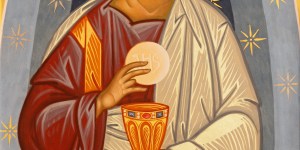Lenten Campaign 2025
This content is free of charge, as are all our articles.
Support us with a donation that is tax-deductible and enable us to continue to reach millions of readers.
As early Christians built their own churches and were no longer under persecution, they began to find creative ways to reserve the consecrated hosts from Mass.
The main purpose of reserving Eucharistic hosts at this time in Church history was to distribute these later to the sick and homebound. As a result, they did not need large tabernacles, but only small receptacles.
One of the more popular receptacles was a box in the shape of a dove.
In the late 19th-century book Notitia eucharistica, the author traces the roots of this custom to the 5th century.
Since the very beginning of Christianity the dove symbolized the Holy Spirit, and it was a fitting symbol for the receptacle of the consecrated hosts. The dove recalls the calling down of the Holy Spirit by the priest at Mass before the consecration, as it is written in current Eucharistic Prayer II.
This custom of preserving the Eucharist in a dove-shaped box continued for many centuries, possibly up until the 11th or 12th century. At that time eucharistic devotion was increasing and larger, more ornate boxes began to be constructed.










